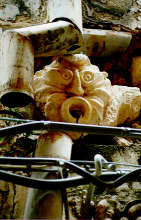| Typology of the intervention | C Preparation of the masonries C.1 Defence salty migrations C.1.2 Temporary plaster |
| Purpose of the work | The masonry shows the plaster very deteriorated or absent, marked, in one or more parts; deterioration due:
Under these conditions the masonry has been shown saturated of soluble salts. It needs, before providing to any intervention, to extract soluble salts. |
| Formality of the intervention | Before effecting the laying of the temporary plasters is necessary to perform:
In the so prepared masonry is spread a layer of plaster, with limited thickness, manufacturing a generic mortar. |
| Specifications on the materials | The temporariness of the intervention doesn't require a detail care in the preparation of the plaster, that can be constituted by a layer, of limited thickness, obtainable with a ordinary lime mortar. The medium/coarse- grained aggregates, deprived of dusts, of salts and of other polluting substances, must be clean. |
| Warning | Between the mortar and the wall (made damp from the cleaning and from the ordinary mortar on this applied) an osmotic phenomenon occurs; in presence of two different salty concentration solutions (the wall and the mortar) the transfer of salts is activated in direction of the small concentration solution (the temporary plaster). In the extreme case of a ordinary mortar (because of a polluted aggregate) with a salty concentration greater than that present in the masonry, stretching the plaster, exists the risk to introduce salts rather than to extract them. |
Summarizing files for a critical reflection on the effects of the workmanships
C.1.2 - elements of judgment |
|
Effects |
Description |
action |
salts' extraction |
control of action |
impossible |
check of action |
possible |
time of intervention |
long |
collateral effects |
absent |
Elements of analysis |
Description |
maintenance of informative content |
not remarkable |
potential reversibility |
reversible |
compatibility with the support |
good |
easy application |
good |
possibility of maintenance |
non remarkable |
duration of the effects |
immediate effect |
cost |
low |


